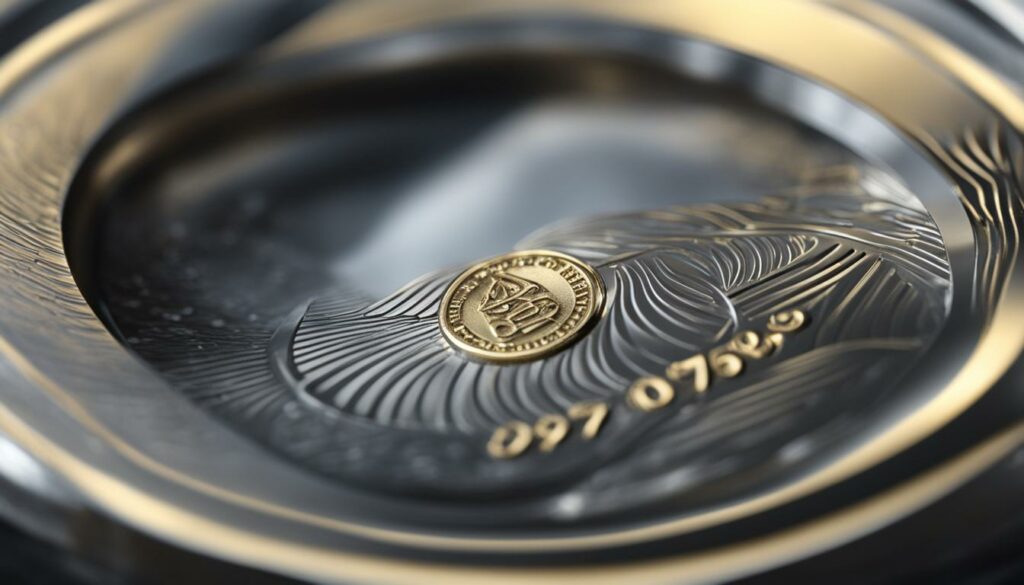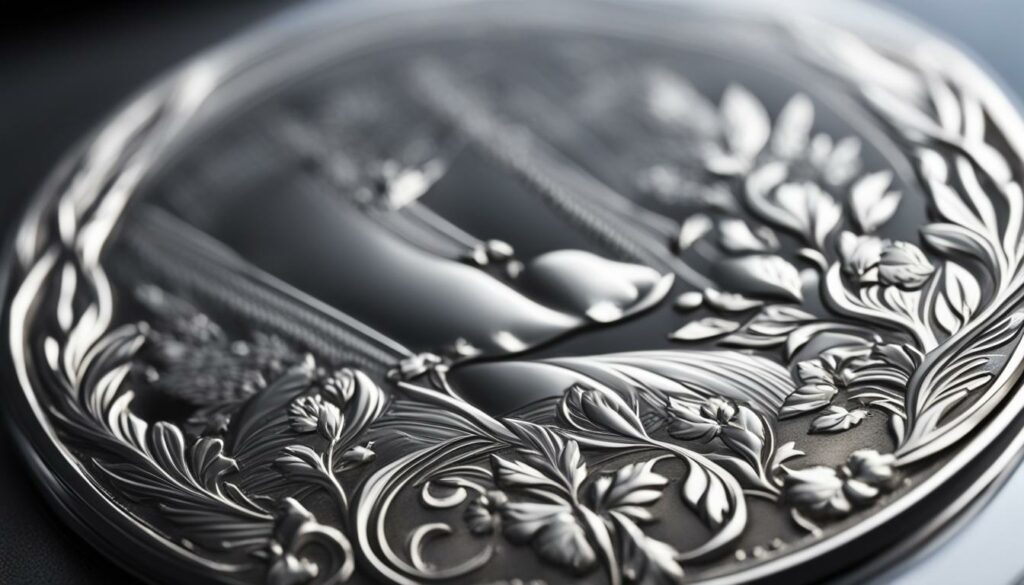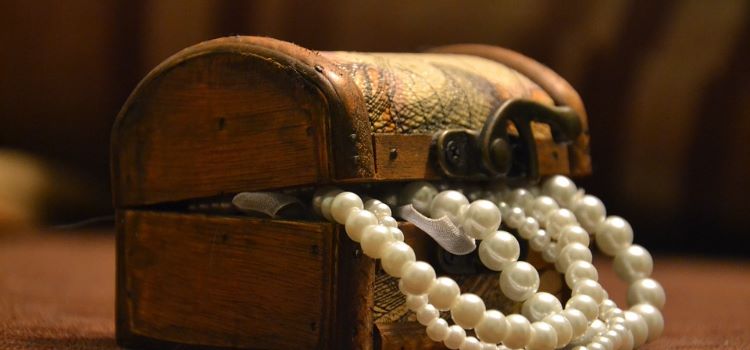Welcome to my blog where we delve into the fascinating world of jewelry symbols and their meanings. Jewelry markings, known as hallmarks, are like hidden messages waiting to be deciphered. They can reveal intriguing details about the origin, age, and metal type of a piece of jewelry. From mystical symbols to sentimental emblems, each stamp holds a story. Join me on this journey as we unravel the symbolism in jewelry.
As an avid jewelry enthusiast, I have always been captivated by the intricate symbols and markings found on different pieces. These symbols can convey deep meanings, making jewelry not just a fashion statement but also a personal expression. Whether you’re curious about the significance of a specific stamp or want to explore the hidden messages behind popular jewelry symbols, this blog is your guide.
We’ll be diving into various types of jewelry stamps, including hallmarks, maker’s marks, purity stamps, and location stamps. Each section will shed light on different aspects of jewelry symbolism, helping you unlock the secrets behind the symbols you wear.
So, grab your favorite piece of jewelry and join me as we embark on this captivating journey through the world of jewelry symbols and their meanings!
Hallmarks: Identifying Origin, Date, and Metal Type
Hallmarks are crucial markings found on jewelry that provide valuable information about their origin, date of manufacture, and metal type. These hallmarks serve as a guide for buyers and collectors in determining the authenticity and quality of the piece. Understanding the significance of these markings is essential for anyone interested in the world of jewelry.
One of the most common types of hallmarks is the origin stamp, which indicates the country where the jewelry was manufactured. Each country often has its own unique system of hallmarks, featuring symbols, numbers, and letters. For example, in England, hallmarking originated in the 1300s and included markings that represented purity, the maker’s mark, and the year of manufacture. Similarly, countries such as France, Germany, and the United States adopted their own hallmarking systems over time.
Date stamps are another important aspect of hallmarks. They reveal the year in which the jewelry was produced, helping to determine its age and historical significance. These date stamps can vary based on the country or region of origin. By decoding the date stamp, collectors can uncover the rich history behind a piece of jewelry.
“Hallmarks are like a secret language woven into the fabric of jewelry. They tell the story of where it came from and the time it was made. Each mark holds a piece of history, waiting to be uncovered and appreciated.” – Jewelry expert
Metal stamps are perhaps the most well-known type of hallmark as they provide information about the composition of the jewelry. These stamps indicate the metal type used, such as gold, silver, platinum, or stainless steel. Furthermore, purity stamps are used to denote the percentage of precious metal content within the piece. For example, a 925 stamp indicates sterling silver, while stamps like 10K, 14K, 18K, and 24K indicate varying purities of gold.
Exploring the hallmarks stamped on jewelry allows us to delve deeper into the world of gold, silver, and other precious metals. By deciphering these symbols and markings, we gain a greater appreciation for the craftsmanship and history behind each piece. Hallmarks are not merely stamps on jewelry; they are gateways to a hidden world of stories waiting to be discovered.
Maker’s Marks: Identifying the Designer or Manufacturer
When it comes to jewelry, the maker’s mark is like the artist’s signature. It is a symbol or initials that identify the designer or manufacturer of a piece. These marks can be in the form of a logo, a unique symbol, or the artist’s initials or name. In some cases, jewelry manufacturers may also use maker’s marks to establish the authenticity of their products.
The presence of a maker’s mark on a piece of jewelry provides valuable information about its origin and craftsmanship. Knowing the designer behind a piece can give you a deeper appreciation for its uniqueness and quality. It can also serve as a way to distinguish genuine pieces from replicas or imitations.
Some renowned jewelry designers have iconic maker’s marks that are instantly recognizable. For example, the interlocking “CC” logo is associated with Coco Chanel, while the iconic “Tiffany & Co.” stamp is synonymous with quality and luxury. These maker’s marks not only add value to the jewelry but also make them highly sought after by collectors and enthusiasts.
The Importance of Authenticity
Identifying and understanding maker’s marks is crucial for both buyers and sellers of fine jewelry. It helps ensure the authenticity and provenance of the piece, protecting consumers from counterfeit or fraudulent jewelry. Moreover, knowing the designer behind a piece of jewelry adds a personal touch and narrative to the item, making it even more special and meaningful.
Table: Famous Maker’s Marks in Jewelry
| Designer | Maker’s Mark |
|---|---|
| Tiffany & Co. |  |
| Coco Chanel |  |
| Cartier |  |
| David Yurman |  |
As you explore the world of jewelry, take a closer look at the maker’s marks on the pieces you encounter. They are not just stamps of identification, but also symbols of craftsmanship, creativity, and authenticity. Each mark tells a story, connecting you to the hands that created the beautiful jewelry you wear and cherish.
Purity Stamps: Identifying the Metal Content
When examining jewelry, one important aspect to consider is the purity of the metal used. Purity stamps play a crucial role in identifying the metal content of a piece, providing valuable information about its composition. These stamps can indicate the type of metal, its purity percentage, and the fineness of the metal. By understanding these stamps, you can make informed decisions about the quality of the jewelry you purchase.
One commonly encountered purity stamp is 925, which signifies sterling silver. This stamp indicates that the jewelry is made of 92.5% pure silver and 7.5% other metals, often copper. The 925 stamp is typically found on rings, pendants, and bracelets made of sterling silver. It is important to note that the 925 stamp may also include letters or symbols indicating the maker’s mark or the brand of the jewelry.
For gold jewelry, purity stamps specific to different karat weights are used. Stamps like 10K, 14K, 18K, and 24K indicate the purity of the gold used. For example, 10K gold is 41.6% pure gold, while 24K gold is 100% pure. These stamps are commonly located on the inside of a ring band or on the back of necklaces and bracelets. By recognizing these purity stamps, you can determine the quality and value of the gold in your jewelry.
| Purity Stamp | Metal Content |
|---|---|
| 925 | Sterling Silver (92.5% pure silver) |
| 10K | 41.6% pure gold |
| 14K | 58.3% pure gold |
| 18K | 75% pure gold |
| 24K | 100% pure gold |
When it comes to platinum jewelry, purity stamps are used to identify the percentage of platinum present. One common stamp is 900 Plat, which signifies that the jewelry is 90% platinum. Other stamps like 950 Pt indicate 95% platinum content. These stamps may also include letters indicating the presence of other metals, such as palladium, which is often used in platinum alloys. Understanding these purity stamps ensures that you can accurately identify platinum jewelry.
By paying attention to purity stamps, you can determine the metal content of jewelry and make informed decisions about your purchases. Whether it’s sterling silver, gold, or platinum, these stamps provide valuable information about the quality and purity of the metal used in your favorite pieces.

Jewelry Origin Stamp: Unveiling the Roots of Your Precious Pieces
When examining a piece of jewelry, one of the key details to look for is the origin stamp. These stamps provide valuable information about where the jewelry was manufactured or produced, shedding light on its heritage and authenticity. The origin stamp is often represented by a symbol or abbreviation that represents a specific country or region.
For example, a stamp of “925” signifies sterling silver, which is commonly associated with jewelry originating from the United States. Other stamps, such as “750” for gold, indicate the purity of the metal used and may vary depending on the country of origin. These stamps not only provide insight into the origins of the jewelry, but they also play a crucial role in ensuring its quality and value.
To better understand the meaning behind origin stamps, refer to the table below:
| Origin Stamp | Country/Region |
|---|---|
| 925 | United States |
| 750 | Italy |
| 585 | Germany |
| 916 | India |
| 999 | China |
By understanding these origin stamps, you can gain a deeper appreciation for your jewelry’s cultural heritage and make more informed purchases. So next time you come across an origin stamp, take a moment to unravel the story behind your precious pieces.

Did You Know? The Intriguing World of Jewelry Origin Symbols
Not all origin stamps are straightforward numbers. Some countries or regions use symbols or abbreviations to represent their origin. For example:
- Punch mark: Used in France to signify the provenance of a piece of jewelry.
- Initials or letters: Commonly used in the United Kingdom and represent the maker’s mark or the city where the jewelry was crafted.
- National emblem: Some countries incorporate their national emblems, such as a crown or eagle, as an origin stamp to denote the jewelry’s country of origin.
These symbols and abbreviations add an element of mystique to the world of jewelry, making each piece a unique reflection of its cultural origins.
925 Stamps: Identifying Sterling Silver Jewelry
Sterling silver jewelry is a popular choice for its timeless elegance and affordability. To identify sterling silver jewelry, look for the 925 stamp. This stamp indicates that the piece is made of 92.5% pure silver, with the remaining 7.5% made up of other metals, often copper. The 925 stamp is usually found on rings, pendants, and bracelets made of sterling silver.
The 925 stamp may also include additional letters or symbols that represent the maker’s mark, such as the iconic Tiffany & Co. stamp. These maker’s marks add a touch of authenticity and craftsmanship to the piece. When purchasing sterling silver jewelry, it’s important to look for the 925 stamp to ensure the quality and purity of the metal.

Benefits of Sterling Silver Jewelry
Sterling silver jewelry offers several benefits that make it a popular choice among jewelry enthusiasts. Firstly, sterling silver is hypoallergenic, making it suitable for those with sensitive skin. It is also durable and resistant to tarnishing when properly cared for. Additionally, sterling silver can be easily cleaned and maintained, ensuring that your jewelry retains its shine and luster over time.
Furthermore, sterling silver jewelry comes in a wide range of designs and styles, allowing you to express your personal style and complement any outfit. Whether you prefer minimalist and delicate pieces or bold and statement-making designs, there is sterling silver jewelry to suit every taste and occasion.
How to Care for Sterling Silver Jewelry
To keep your sterling silver jewelry looking its best, it’s important to take proper care of it. Here are some tips to help you maintain the beauty and longevity of your sterling silver pieces:
- Store your sterling silver jewelry in a cool, dry place, away from direct sunlight and moisture.
- When not wearing your jewelry, store it in a jewelry box or airtight bag to prevent tarnishing.
- Avoid exposing your sterling silver jewelry to harsh chemicals, such as chlorine or household cleaners, as they can damage the metal.
- Clean your jewelry regularly using a soft cloth or specialized silver polishing cloth to remove any tarnish or smudges.
- For stubborn tarnish, you can use a mild silver polish or a homemade cleaning solution of baking soda and warm water.
By following these simple care tips, you can keep your sterling silver jewelry looking beautiful and radiant for years to come.
Gold Purity Stamps: Identifying the Purity of Gold Jewelry
When it comes to gold jewelry, it’s important to understand the markings that indicate the purity of the gold. Gold purity stamps are one way to determine the authenticity and quality of the gold used in a piece of jewelry. These stamps, such as 10K, 14K, 18K, and 24K, provide valuable information about the percentage of pure gold in the jewelry.
For example, a 10K stamp indicates that the jewelry is made of 41.6% pure gold, while an 18K stamp signifies 75% pure gold. The higher the karat value, the higher the gold content in the jewelry. It’s essential to note that 24K gold is considered pure gold, as it contains 100% gold.
Understanding these gold purity stamps can help you make informed decisions when purchasing gold jewelry. It allows you to choose jewelry that aligns with your desired gold purity level and budget. Whether you’re looking for a piece of jewelry with a higher gold content or prefer a lower gold content for durability, these stamps provide the necessary information to guide your selection.
| Karat Stamp | Gold Content |
|---|---|
| 10K | 41.6% pure gold |
| 14K | 58.3% pure gold |
| 18K | 75% pure gold |
| 24K | 100% pure gold |
Remember, gold purity stamps provide essential information about the gold content in jewelry, allowing you to choose pieces that suit your preferences and budget. Whether you’re in search of a stunning 18K gold necklace or a more affordable 10K gold ring, these stamps are your key to unlocking the purity of gold jewelry.
Expert Tip: Understanding Karat vs. Carat
It’s crucial to differentiate between the terms “karat” and “carat” when discussing gold jewelry. Karat represents the purity of gold, as we’ve seen with the gold purity stamps. On the other hand, “carat” refers to the weight of gemstones, such as diamonds and rubies. These terms may sound similar, but they have completely different meanings and are not interchangeable when discussing jewelry.
Platinum Identifier Stamps: Identifying Platinum Jewelry
Platinum is a precious metal often used in jewelry for its durability and lustrous appearance. To identify platinum jewelry, specific stamps and markings are used. These symbols indicate the purity and composition of the metal, ensuring buyers can make informed decisions about their purchases. Let’s explore the different platinum stamps and what they mean.
One common platinum stamp is “900 Plat” or “900pt.” This stamp indicates that the jewelry is made with 90% platinum and 10% other metals, which are typically alloys like iridium or ruthenium. The “900” in the stamp represents the purity of the platinum, signifying that it is a high-quality piece. It’s essential to recognize this stamp when shopping for platinum jewelry to ensure you are getting genuine platinum.
In some cases, platinum jewelry may also include additional letters or numbers in the stamp. These markings can indicate the presence of other metals used in the alloy. For example, a stamp like “Pt950IR” signifies that the jewelry contains 95% platinum and 5% iridium. These additional symbols provide further details about the composition of the platinum and can be useful for buyers seeking specific characteristics in their jewelry.
| Platinum Stamp | Purity | Composition |
|---|---|---|
| 900 Plat | 90% platinum | 10% other metals |
| Pt950IR | 95% platinum | 5% iridium |
| Pt950RU | 95% platinum | 5% ruthenium |
When purchasing platinum jewelry, it is crucial to look for these stamps and markings to ensure the authenticity and quality of the piece. The presence of these identifiers assures you that you are investing in genuine platinum, known for its durability and timeless beauty.
Gold Plating Stamps: Identifying Gold Plated Jewelry
Gold plating stamps are valuable indicators for identifying gold plated jewelry. These stamps provide crucial information about the type and quality of gold plating used on a piece. Common stamps include GE (gold electroplated), HE (heavy gold electroplated), GP (gold plated), and GF (gold bonded). These stamps not only assure buyers of the presence of gold but also indicate the thickness and longevity of the plating.
Gold electroplating involves the process of depositing a thin layer of gold onto the surface of another metal, typically using an electric current. This method is widely used in the jewelry industry to add the luxurious appearance of gold to base metals. The gold plating stamps act as a guarantee that the jewelry item incorporates this gold electroplating technique.
“Gold plating stamps offer credibility and transparency in the jewelry market, allowing consumers to make informed decisions based on their personal preferences and budget.”
When purchasing gold plated jewelry, it’s essential to be familiar with these stamps to ensure you’re getting the quality and durability you desire. The gold plating stamp will also help you differentiate between gold plated and solid gold jewelry, assisting you in determining the value and price point that best suits your needs.
Remember, the presence of a gold plating stamp guarantees that the jewelry item has undergone meticulous electroplating, giving it a stunning gold finish. So the next time you spot a piece of gold plated jewelry, look for these stamps to ensure you’re investing in a high-quality item that will retain its beauty for years to come.
| Stamp | Meaning |
|---|---|
| GE | Gold Electroplated |
| HE | Heavy Gold Electroplated |
| GP | Gold Plated |
| GF | Gold Bonded |
Stainless Steel Stamps: Identifying Stainless Steel Jewelry
When it comes to jewelry, stainless steel has gained popularity for its durability and affordability. But how can you tell if a piece of jewelry is made from stainless steel? Look for the stainless steel stamp. This stamp is a small marking on the jewelry that indicates its metal composition. By understanding stainless steel stamps, you can confidently identify and appreciate your stainless steel jewelry.
The stainless steel stamp typically consists of the letters “SS” or the words “Stainless Steel” engraved or imprinted on the jewelry. This stamp is often located on the clasp of necklaces or bracelets, the inside of rings, or the back of pendants and earrings. Some manufacturers may also include a number to indicate the specific grade of stainless steel used, such as “316L” or “304.”
Stainless steel stamps are important because they provide assurance that the jewelry you’re purchasing or wearing is indeed made from stainless steel. This metal is known for its resistance to tarnish, corrosion, and rust, making it an excellent choice for everyday wear. Additionally, stainless steel is hypoallergenic, making it suitable for those with sensitive skin. So, the next time you come across a piece of jewelry with a stainless steel stamp, you can be confident in its quality and durability.
Antique Stamps: Identifying Antique Jewelry
Antique jewelry holds a special allure, with its intricate designs and rich history. One way to authenticate and identify antique pieces is through the use of antique stamps. These unique markings provide valuable clues about the age, origin, and craftsmanship of the jewelry.
Antique stamps often begin with the letter “A” followed by other letters or symbols that provide additional information. These markings can include the type of metal used, such as “A925” for sterling silver or “A750” for 18K gold. They may also indicate the country of origin, with stamps like “A925UK” for antique silver from the United Kingdom or “A750FR” for antique gold from France.
Identifying antique jewelry markings requires careful research and expertise. Collectors and enthusiasts often consult reference books and online resources to decode these stamps and unravel the hidden stories behind each piece. It is important to note that not all antique jewelry will have stamps, as some pieces may have worn away over time or were never stamped to begin with. In such cases, it becomes even more crucial to rely on other identifying characteristics, such as the style, materials, and craftsmanship of the piece.
Understanding antique stamps can help you appreciate the value and rarity of antique jewelry. Each stamp is a testament to the artistry and craftsmanship of a bygone era, making antique jewelry a cherished and timeless treasure.
| Antique Stamp | Meaning |
|---|---|
| A925 | Sterling silver |
| A750 | 18K gold |
| A925UK | Antique silver from the United Kingdom |
| A750FR | Antique gold from France |
What Do White Gold Symbols Stamped on Jewelry Mean?
White gold symbols stamped on jewelry hold significant meaning and help identify the composition of the piece. When purchasing or admiring white gold jewelry, it’s important to understand the symbolism behind these markings.
White gold, a popular choice for its elegant appearance, is crafted by combining gold with other metals such as silver, nickel, or palladium. The resulting alloy is then stamped with symbols indicating the percentage of pure gold in the jewelry.
Typically, white gold symbols include a karat marking (K or k) followed by a number. The number represents the proportion of pure gold in the alloy. For example, a stamp of 14K signifies that the jewelry contains 58.3% pure gold, while a stamp of 18K indicates a higher purity level of 75% gold content.
These symbols not only provide valuable information about the gold content but also contribute to the overall aesthetic and value of the piece. A deeper understanding of white gold markings allows you to make informed decisions when purchasing or evaluating the authenticity and quality of white gold jewelry.
What Jewelry Stamp is Used for Solid Gold?
When it comes to identifying solid gold jewelry, there are specific stamps that indicate the karat weight, which represents the purity of the gold. These stamps are essential for both buyers and sellers to understand the quality and value of the gold used in the jewelry.
The most common stamps for solid gold include the 10K and 18K markings. The 10K stamp signifies that the jewelry is 41.6% pure gold, while the 18K stamp indicates that it contains 75% pure gold. These stamps are usually found on rings, necklaces, bracelets, and other gold jewelry pieces.
It’s important to note that the karat marking is different from the carat weight used for measuring gemstones. Karat represents the purity of gold, while carat measures the weight of gemstones. So, when you see a gold stamp with a karat marking, it tells you how much pure gold is in the piece.
By understanding the meaning behind these solid gold stamps, you can confidently identify and appreciate the quality of your gold jewelry.
| Stamp | Purity |
|---|---|
| 10K | 41.6% pure gold |
| 18K | 75% pure gold |
Does Silver-Plated Jewelry Have a Stamp?
When it comes to identifying the silver content in jewelry, stamps and markings play a crucial role. However, if you’re looking for a stamp on silver-plated jewelry, you may be disappointed. Unlike sterling silver, silver-plated jewelry does not have a specific stamp indicating its silver content. This is because silver-plated jewelry is made from a base metal that is coated with a thin layer of silver, rather than being made entirely of pure silver.
So, if there’s no stamp, how can you determine if the jewelry is silver-plated? One clue is the absence of the widely recognized 925 stamp, which signifies sterling silver. The 925 stamp is not used on silver-plated items because they do not contain a significant amount of pure silver like sterling silver does. Instead, silver-plated jewelry often has a notation or label indicating its silver-plated status, which may be mentioned on the packaging or in the item description.
It’s important to note that while silver-plated jewelry lacks the durability and long-lasting value of sterling silver, it can still be a cost-effective and stylish choice. Silver-plated pieces offer the look of silver at a more affordable price point, making them accessible to a wider range of budgets. Just be mindful that the silver plating may wear off over time, revealing the base metal beneath. Taking proper care of silver-plated jewelry, such as avoiding exposure to harsh chemicals and storing it in a dry place, can help prolong its lifespan.
The 925 Stamp on Silver-Plated Jewelry
Some silver-plated jewelry may feature a 925 stamp, which can be confusing for buyers. This stamp does not indicate that the jewelry is made of sterling silver, but rather that it has a layer of silver plating. The 925 stamp is often used to enhance the perceived value and quality of silver-plated items. It’s important to carefully read the product description and consult the seller if you’re unsure about the silver content of a piece of jewelry.
In conclusion, silver-plated jewelry does not have a specific stamp indicating its silver content. While it may lack the longevity of sterling silver, silver-plated jewelry can still be an attractive and affordable option for adding a touch of silver elegance to your style.
Conclusion
Jewelry symbolism runs deep, with hidden meanings and messages imbued in the symbols stamped on each piece. From love and eternity to protection and luck, these symbols add a touch of personal significance to your style. Understanding the different stamps and symbols used in jewelry enhances your appreciation for the pieces you own or plan to purchase.
Symbolic jewelry allows you to wear and carry these meaningful symbols with you throughout your day, serving as a reminder of what they represent. The infinity symbol signifies eternal love and friendship, while the evil eye offers protection against negative energy. A love knot represents an unbreakable bond, and a heart symbolizes deep affection and devotion.
By choosing jewelry with symbols that hold personal significance or resonate with you, you can express your individuality and create a unique style statement. Symbolic jewelry also makes for thoughtful and meaningful gifts, allowing you to convey your sentiments and intentions in a beautiful and lasting way.
FAQ
What are jewelry hallmarks?
Jewelry hallmarks are symbols, numbers, or letters used to identify different features of a piece of jewelry, including its origin, date of manufacture, and metal type.
What are maker’s marks?
Maker’s marks are used to identify the jewelry designer or artist who created the piece. They can be in the form of a logo or the artist’s initials or name.
What are purity stamps?
Purity stamps are used to identify the purity of the metal used in a piece of jewelry. They indicate the metal content, purity percentage, and fineness.
What are location stamps?
Location stamps are used to identify the origin of a piece of jewelry. They provide information about where the jewelry was manufactured or produced.
What does a 925 stamp mean?
A 925 stamp is used to identify sterling silver jewelry, which consists of 92.5% pure silver and 7.5% other metals, often copper.
What do gold purity stamps indicate?
Gold purity stamps, such as 10K, 14K, 18K, and 24K, indicate the purity of gold used in jewelry, with 24K symbolizing 100% pure gold.
How are platinum identifier stamps used?
Platinum identifier stamps, like 900 Plat or Pt900, indicate that a piece of jewelry contains a certain percentage of platinum, often combined with other metals.
How can gold plating stamps be identified?
Gold plating stamps like GE, HE, GP, and GF are used to indicate jewelry that has been coated or bonded with a layer of gold.
What do stainless steel stamps signify?
Stainless steel stamps are used to indicate that a piece of jewelry is made from stainless steel, known for its affordability and hypoallergenic properties.
How are antique stamps used in identifying antique jewelry?
Antique stamps often begin with the letter “A” and may be accompanied by other letters indicating the type of finish or plating used, providing insight into the age and value of the piece.
What do white gold symbols stamped on jewelry mean?
White gold symbols stamped on jewelry indicate the karat weight, representing the purity of the gold alloy used in creating the piece.
How are solid gold jewelry stamps used?
Solid gold jewelry stamps indicate the karat weight, revealing the purity of the gold used. Common stamps include 10K and 18K.
Does silver-plated jewelry have a stamp?
No, silver-plated jewelry does not have a stamp indicating its silver content. It consists of a base metal coated with a thin layer of silver.
What do symbols stamped on jewelry signify?
Symbols stamped on jewelry can convey various meanings such as love, eternity, protection, and more, adding personal significance and sentiment to the piece.
Source Links
- https://brite.co/blog/jewelry-stamps-and-what-they-mean/
- https://azurajewelry.com/blogs/azura-blog/what-does-the-symbols-on-your-jewelry-mean
- https://www.langantiques.com/university/symbolism-in-jewelry/

Hey Fashion Enthusiasts! My wife Chantal and I, have been so fortunate to be able to share our latest inspiration and trends in the jewelry and accessory industry, and more so, to get this amazing feedback from our ever growing community. Where my wife focusses more on all things rings, weddings and female jewelry, I love to scoop out the newest accessories for men. I roam around the world to find the latest watches, bags, sunglasses, scarfs, wallets, you name it and I’ll deliver! I always commit to doing a lot of research to share my reviews and personalized advice on this blog or on our store. If you do not know what to wear, send me an email and I will help you out!




